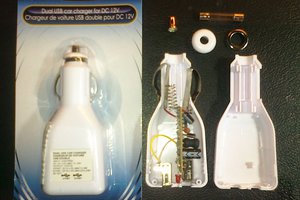This project presents a nominally 12V to 5V step down power adapter for use in a motor vehicle to supply 5V at up to 2A from a USB socket.
It is intended to be plugged into a cigar lighter socket and can be used with any device that is normally charged from a 5V USB power outlet at up to 1.8A.
Although most recent cars already have built in USB sockets suitable for such use, some may not be capable of supplying enough current to charge devices such as tablets and smartphones. Many cars designed before about 2010 may not have USB outlets at all.
However, most vehicles have cigar lighter outlets allowing a high current connection directly into the vehicle 12V supply. This is clearly unsuitable for use to directly charge 5V input devices so some form of voltage reduction and - due to the noisy and very roughly regulated battery voltage behaviour - voltage regulation is required.
Many of the designs for 12V to 5V adapters already freely available on the web use linear regulation, which will dissipate somewhere in the region of 15W to 20W at a 2A load at maximum alternator output and so require significant heat sinking.
Most do not provide any form of input over-voltage protection against alternator load dump (See:https://en.wikipedia.org/wiki/Load_dump) or input reverse polarity connection.
Most do not provide any form of output over-voltage protection in the event of a short circuit failure of the series voltage regulation element, which could result in the connection of the 12V input supply directly to the 5V output.
It is not clear what level of protection is provided by commercially available devices offered for sale.
A review of many of the designs and products offered on the web did not inspire confidence in the safety of connecting an expensive, high-end tablet or smartphone to any of them.
This project presents a design offering clearly defined protection of both input and output connections.
1) Input voltage
8V to 55V DC
2) Load Dump and input reverse polarity protection:
The input side is designed to operate from the nominal 12V vehicle supply but is able to withstand transients, including - in the event of accidental or intermittent vehicle battery disconnection - alternator load dump, up to 55V. It is also protected against accidental reverse polarity connection of the input supply.
3) EMI filtering:
The input side also has low pass filtering to reduce noise being imported into the regulator from the vehicle supply.
The same filtering reduces switching noise being exported from the regulator into the vehicle supply to minimise the possibility of interference with other vehicular equipment.
The filtering is also designed to ensure the stability of the input to the regulator at all input voltages.
4) Output short circuit and over-voltage protection:
The 5V output is protected against output short circuit faults.
The 5V output is also protected against device failure that could result in the 12V input being imposed directly onto the 5V output, such as a series switch transistor failure in the step down regulator chip. In the event of such a failure, the instantaneous voltage imposed on the 5V output is clamped to just below 5.7V. A few milliseconds after the output over-voltage is clamped to 5.7V, a series 2A fuse blows, providing a permanent disconnection from the vehicle supply.
The presence of input and output voltages are indicated by separate green (input) and red (output) LEDs.
5) Output voltage and current:
5V+/-0.25V at up to 1.8A (limited by the rating of the output side USB connector, the regulator chip can supply up to 2A with an up-rated connector).
- Please note however, that this is not a cheap project to build for two reasons.
a) the L4978 switch mode regulator is one of the few through hole parts available that meet the 8V to 55V input voltage range requirement. Whilst there are cheaper devices available in surface mount packaging, in the interests of making this project accessible to the widest range of users, it was decided to avoid...
Read more »

 hesam.moshiri
hesam.moshiri

 W4KRL
W4KRL
Hi Allan,
Looking back at the test results, maybe they could be a bit clearer.
The "Load current" is the current supplied to the load connected to the nominally 5V output.
The "Supply current" is drawn from the nominally 12V input supply.
This is the other way round to how you have interpreted the figures.
:)